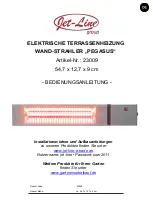
18
WARNING
The valve lever MUST be operated AT LEAST ONCE A
YEAR to ensure that the water-ways are clear. Certain
naturally occurring mineral deposits may adhere to the
valve, rendering it inoperative. When manually operating
the lever, water will discharge and precautions must be
taken to avoid contact with hot water and to avoid water
damage. BEFORE operating lever, check to see that a
discharge line is connected to this valve directing the
flow of hot water from the valve to a proper place of
disposal otherwise personal injury may result. If no water
flows, valve is inoperative. TURN OFF THE UNIT AND
CALL A PLUMBER IMMEDIATELY.
NOTE
This device is designed for emergency safety relief and
shall not be used as an operating control.
NOTE
The Lead Free automatic re-setting T&P relief valve shall
comply with states codes and standards, where requiring
reduced lead content. The wetted surface of this product
contacted by consumable water contains less than
0.25% of lead by weight.
No valve is to be placed between the relief valve and
the appliance
. To prevent water damage, the discharge
from the relief valve shall be piped to a suitable floor drain
for disposal when relief occurs. No reducing couplings or
other restrictions shall be installed in the discharge line. The
discharge line shall allow complete drainage of the valve
and line. Relief valves should be manually operated at least
once a year. If a relief valve discharges periodically, this
may be due to thermal expansion in a closed water supply
system. Contact the water supplier or local plumbing
inspector on how to correct this situation.
Do not plug the
relief valve.
CAUTION
Avoid contact with hot discharge water.
NOTE
A relief valve functions in an emergency by discharging
water. Therefore, it is essential that a discharge line be
piped from the valve in order to carry the overflow to a
safe place of disposal. The discharge line must be the
same size as the valve outlet and must pitch downward
from the valve and terminate at least 6"(152mm) above
the floor drain where any discharge will be clearly visible.
6.2.2
– Re-inspection of T&P relief valve
Temperature and Pressure Relief Valves should be re-
inspected AT LEAST ONCE EVERY TWO TO FOUR
YEARS by a licensed plumbing contractor or authorized
inspection agency, to insure that the product has not been
affected by corrosive water conditions and to insure that the
valve and discharge line have not been altered or tampered
with illegally. Certain naturally occurring conditions may
corrode the valve or its components over time, rendering
the valve inoperative.
Such conditions are not detectable unless the valve and its
components are physically removed, and inspected. Do not
attempt to conduct this inspection on your own. Contact
your plumbing contractor for a re-inspection to assure
continuing safety.
WARNING
FAILURE TO REINSPECT THIS VALVE AS DIRECTED
COULD RESULT IN UNSAFE TEMPERATURE OR
PRESSURE BUILD-UP, WHICH CAN RESULT IN
SERIOUS INJURY OR DEATH AND/OR SEVERE
PROPERTY DAMAGE.
6.3
– Aquastat (Manual Reset)
To adjust the setpoint:
Insert a screwdriver in the slotted head visible through the
cover, and turn the indicating dial to the control point.
Differential (on adjustable differential models): Remove
cover and move the differential adjustment wheel (Figure
below) to a point on the scale corresponding to the desired
differential. Replace cover.
Manual Reset (L4008E): After water temperature has
dropped to a point below the high limit setting, less
differential, the reset button at the front of the case must be
pushed before the burner can operate.
6.4
– Circulator Pump
6.4.1
– Overview
The circulators mounted on DynaFLO are maintenance
free, Self-lubricated by the system fluid. These circulators
have no seal to leak or coupling to break.








































